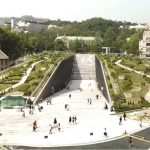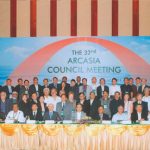The relationship between religion and architecture is one that never weakens. It is religion which plays the most pivotal part in controlling a society and places of worship become the centres around which communities are built. In the formation of a community, it has always been religious buildings which have taken priority and it is around such structures that communities are formed. This is why designing and implementing places of worship is not only a great responsibility but an immense honour.
Text and Photography Vinuri Ethapane
Valentine Gunesekara, an architect devoted to his religion above all else has not only designed a number of churches but has also revolutionised the way in which churches were built. It was his ambition to reform the church architecture of Sri Lanka. His creations, philosophies and bold advances in architecture do not go unnoticed. He was an architect determined to revolutionise the church architecture in a post-colonial country, where his colleagues were aiming at revitalising traditional philosophies. His philosophy made him the revolutionary that he is today, however his work, new and alien was looked upon with much scepticism and doubt.
Once again through a different form, he wished to express the freeing nature of religion rather than express an apparent rigidity he thought that conventional churches had.
Gunasekara’s work has often been controversial in one form or the other. The houses he built did not evoke as much controversy as his public buildings did and yet, however controversial, each of his projects held uniqueness, not only in design but in concept. His work on both the Tewatta basilica and the Tewatta church clearly shows him to be an architect who realises his formations as per his philosophy rather than one who adheres to societal norms. In the Tewatta basilica, Gunesekara realises his concept of contemplation through the Sthupa. The front entrance of the basilica is a flat Sthupa form where the centre has been hollowed out to allow in light into the main hall. His ideas for using this Buddhist element on a church facade was to realise his religious philosophy of freedom of thought and freedom of life. He expresses freedom in his designs of churches where the congregation was not to feel restriction; he intended to do away with the formality of conventional church architecture and revolutionise its spaces to show life through religion. In the Tewatta church, the unconventional experiment of the circular congregation area can be understood as an attempt to unite the whole congregation and maybe express unity and continuity, as a circle has no end.
Gunesekara was influenced as all architects, by many Modernists. His creations show strong ties to architects who have pushed boundaries of technology through design. Le Corbusier and Niemeyer were those who left a strong impression on Gunesekara, yet his philosophy cannot be compared to any other before him. Not only did he express his philosophy so strongly through his unorthodox designs, but Gunesekara also pushed the boundaries in the use of technology and materials available at the time. He changed the way in which concrete was used through his sweeping formations and bold spans, which in turn honed the skill and technology of the construction industry of Sri Lanka.
In the Jesuit chapel Bambalapitiya, Gunesekara has stepped away completely from the Orthodox Church formation. The design comprises of a leaner building as he did not confirm to the rigidity of the conventional church and instead, tried to embody the freedom of the ocean. Once again through a different form, he wished to express the freeing nature of religion rather than express an apparent rigidity he thought that conventional churches had. The curved roof of the church reflects the waves of the ocean, depicting the strong sense of freedom that the ocean embodies. Not only was this church unique in formation, it was unique in philosophy and structural execution as well.
Gunesekara was influenced by many designers, yet the most well known influences were Euro Saarinen and Italian architectural engineer Nervi. His love for structural expressionism can be traced to the influence of Saarinen and his daring structural manipulation. This may have been the result of Nervi having worked with cantilevers and volumes of space that pushed convention.
Tewatta church, the unconventional experiment of the circular congregation area can be understood…
This influence can be seen joined with his distinctive philosophy in the church at Horana. The church at Horana is another embodiment of freedom. Its congregation is to gather under the sweeping canopy with no restrictive walls. It could be interpreted as an environment expressive of a freeing quality as it is open to nature, once again a huge leap away from the orthodox formation, staying true to his philosophy, which can be understood as feeling the freeing sense of spirituality. The church in its section shows a daring open span which is far greater than the human scale. This was a mixture of Gunesekara’s love of religion depicting the freeing he felt religion embodies and his love for daring and bold expressions of materials and structural form. This church just as the Tewatta chapel and the Jesuit chapel, Bambalapitiya, embodies the same kind of flowing lucidity as has never been done before in its structural formation.
The church in its section shows a daring open span which is far greater than the human scale.
In an ever-changing society, it is religion which remains a still force rooting a community and grounding its people. Places of worship do not merely house a function. They are designed to make the visitor feel the power of his faith. This does not mean that there is one correct way to express an intangible force through a tangible formation. Architect Valentine Gunesekara has stepped away from convention and experimented by incorporating conventional religion in unconventional expressions of form.
Bibliography
Anoma Pieris (2007), Imagining Modernity








![Fonseka, Michele (1998) Horana church altar [Image from book - Imagining Modernity - Anoma Pieris] Fonseka, Michele (1998) Horana church altar [Image from book - Imagining Modernity - Anoma Pieris]](https://thearchitect.lk/wp-content/gallery/achitectvalentinegunesekara/thumbs/thumbs_8.jpg)
![Picture/Photo Credits -Pathirajah, M. Gunesekara, V (1998) Horana church sketch section [Image from book - Imagining Modernity - Anoma Pieris] Picture/Photo Credits -Pathirajah, M. Gunesekara, V (1998) Horana church sketch section [Image from book - Imagining Modernity - Anoma Pieris]](https://thearchitect.lk/wp-content/gallery/achitectvalentinegunesekara/thumbs/thumbs_9.jpg)










